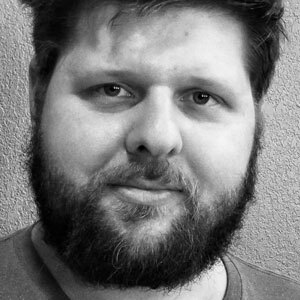Hey all, Ernie here with a piece from David Buck, who felt inspired enough to highlight an offbeat musical icon thanks in part to his appearance in a movie. (Kinda.) Anyway, read on!
Today in Tedium: There is no 20th century composer quite like Louis Hardin, better known as Moondog. Apparently, the director Harmony Korine agrees—as he appears to have named the lead character in his new movie, The Beach Bum, after Moondog, creating an unexpected through line between Matthew McConaughey and the musician and prompting us to revisit the life of one of our favorite composers. His use of unique instruments, tribal rhythms, ambient/environmental sounds, and grasp on counterpoint make for some of the best instrumental music around. Today’s Tedium is not a complete biographical account of the composer, but a celebration of his work and impact on the popular culture of today. Join us on a musical journey as we look into the career of the Viking of Sixth Avenue himself, the one and only Moondog. — David @ Tedium
Keep Us Moving! Tedium takes a lot of time to work on and snark wise about. If you want to help us out, we have a Patreon page where you can donate. Keep the issues coming!
We accept advertising, too! Check out this page to learn more.
1947
The year Louis Hardin changed his professional name to Moondog. According to Robert Scotto’s book Moondog: the Viking of Sixth Avenue, Hardin had already been living, modeling and composing in New York since 1943, but was mostly known as an eccentric with musical talent and lacking direction. Deciding to start over, he based the name on his childhood bulldog Lindy—the dog who constantly howled at the moon.
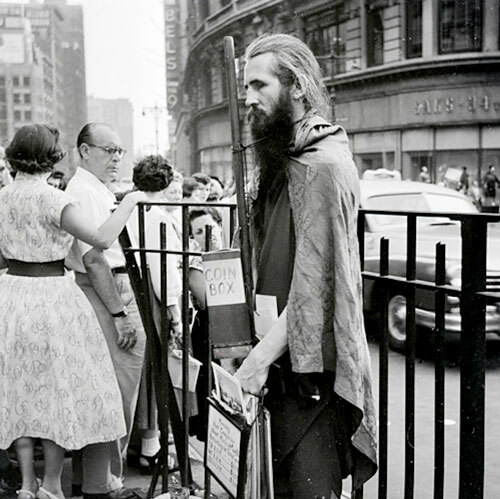
Moondog in his pre-viking days, circa 1953. (via Flickr)
Louis Hardin, a.k.a. Moondog, had a knack for doing things himself from an early age
As the son of a wandering preacher and school teacher, young Louis Hardin moved around constantly. Though Hardin endured a rough and lonely childhood, music was a positive driving force in his life. In Burnt Fork, Wyoming, he would play at “blowout” parties accompanying his mother’s piano and neighbor Uncle George’s fiddle on his own makeshift drum kit. Per Scotto’s biography, the kit consisted of a steamer trunk (as a makeshift kick drum) and a snare drum. He used “shoe-shapers” as drum sticks.
Curious about the world around him, he developed an interest in do it yourself projects. He enjoyed building wooden models and working on projects from the pages of Popular Mechanics or Popular Science. Curiosity led him to pick up an item he found by the railroad tracks that turned out to be a dynamite blasting cap, the explosion of which rendered Hardin blind.
With his life permanently altered by these events, Hardin forged himself a new path—“to become a classical composer.” Hardin proceeded to teach himself to compose and play various instruments. Following the completion of his studies at Iowa School for the Blind, he went off to New York City where he would begin to make his mark.
He wrote his sheet music in Braille. He performed in different time signatures and beat patterns (mostly 5/4), which he called “snaketime.” He recorded an album of nursery rhymes with Julie Andrews in 1957 and was indirectly responsible for the coining of the phrase “rock & roll”. Later, much of his music would be put out on records and be would live with minimalist composer Philip Glass for a year, playing music together. He sold his poetry and music on the streets to earn his living all the while.
Ultimately, Moondog would become well-known in the city (practically a landmark), leave, return, cut a few albums and capture the public imagination for a time before leaving for good in the 1970s.
“As he was evolving his clothing, he was also evolving as a composer. He was looking for a kind of mythic system as a back for his music. So he became The Viking as part of a remaining of himself as this composer who would retell the Nordic myths for the modern world. The Moondog that we know and love and remember actually took about two decades of New York life to evolve.”
— Robert Scotto, author of The Viking of Sixth Avenue, discussing the Viking persona on WMFU last year.
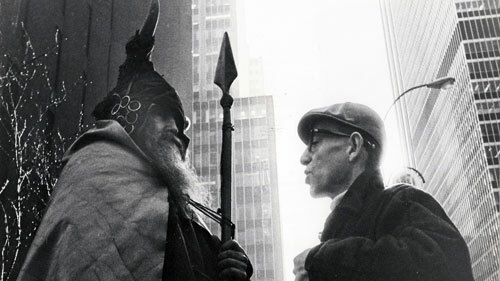
(via The Viking of Sixth Avenue)
How Moondog the musician became Moondog the viking
On the corner of West 54th Street and Sixth Avenue in New York City, Moondog would perform, compose or simply stand while wearing full Viking regalia (horns, spear, cape). The clothing was handmade by the man himself, but the Viking attire didn’t come around until the mid-1960s. People were fascinated by Moondog and many interacted with him, but very few realized he was not a wacky personality or vagrant but a serious composer who dressed this way for a meaningful reason.
In a 1998 interview with Perfect Sound Forever, Hardin tells the story of the Viking:
When I first got to New York and I was attending rehearsals of the Philharmonic, they wrote me up as “a man with the face of Christ.” I put up with that for a few years, getting compared with a monk or Christ, then I said “that’s enough, I don’t want that connection. I must do something about my appearance to make it look un-Christian.” At that time, I was studying the Norse and I felt much closer to that than Christianity so I’d do something to make it look more Nordic. That’s what was behind it.
Moondog wore the Viking outfit up through his first year in Germany, when he met a young lady named Ilona Sommer, who helped transcribe his music and did much to bring spread his music throughout the world. With that association came the end of the Viking attire.
four
The number of 78 RPM singles recorded by Moondog in the late 1940s with the help of Gabriel Oller, the proprietor of Spanish Music Center on Sixth Avenue. The shop no longer exists, but was instrumental in creating these records. The 78s were Snaketime Rhythms (5-beat & 7-beat), Moondog Symphony (which reproduced Moondog’s namesake howling), and two additional singles, Oboe Rounds. Moondog had several albums of his work released over the years including two for Columbia Records—Moondog (1969) and Moondog 2 (1971)_.
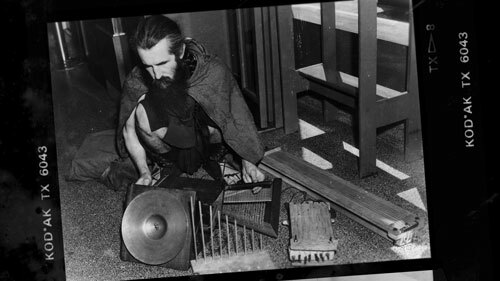
(via The Viking of Sixth Avenue)
Moondog’s musical style: The DIY instruments that defined the artist
The last time we wrote about DIY instruments, we discussed Harry Partch’s homemade instruments. Just like Partch, Moondog made his own instruments because he “believed conventional instruments could not duplicate the sounds he heard in his head.”
Moondog discussed instruments and conducting in a 1974 interview with Sounds:
I like to write. If I have a large orchestra at my disposal, I also conduct. Otherwise, I hardly play instruments, except for a triangular drum that I designed myself.
Moondog invented several instruments that are heard through his various recordings and were a mainstay of his street performances. The most famous of these was the Trimba, a precision percussion instrument. Moondog’s friend and protege Stefan Lakatos performs with them today:
In an interview with Matt Hooke, Lakatos discussed how difficult the Trimba is to make (he had to hire someone to make it based on Moondog’s specifications) and what it’s like to play one. The 47 minute interview is worth checking out for more insight into the instrument and hearing it in action. Per Lakatos, each beat Moondog wrote—5/4, 7/4, and so on—has a particular pattern to it that players must be aware of when performing the music, but despite the challenge, he does an admirable job bringing the sounds to new audiences.
Along with the Tribe, Moondog invented several other instruments heard throughout his works. The following information comes from the back cover of 1956’s More Moondog:
Oo: a triangular stringed instrument struck with a clave.
Trimba: a triangular-shaped drum.
Yuhk: a log suspended from a tripod - hit with two rubber mallets held in right hand.
Tuji: a series of mounted sticks of graduated lengths.
$107,211
The amount a film version of The Viking of Sixth Avenue raised with their following a successful Kickstarter in 2014. Holly Elson’s film has yet to be released, but is nearing completion. The film will contain old footage, pictures and interviews with people who knew Moondog. Speaking of films, Korine’s The Beach Bum features a character named Moondog, played by Matthew McConaughey, who is portrayed as a failed poet who emerges from 1960s hippie culture. The character is in many ways the opposite of Louis Hardin, though they do have some similarities: both are poets, both spend some time with interesting people and both rose to prominence during the tumultuous 1960s. A unique coincidence indeed.
Meet the musicians keeping Moondog’s music alive today
Stefan Lakatos is possibly the greatest individual contributor to keeping the music of Louis Hardin in the public sphere. His own long white beard and physical stature invokes that of Hardin and Stefan’s performances are meticulous tributes to his friend and mentor. Stefan’s mastery of Moondog’s form and instruments can be seen in this 2016 Amsterdam performance as well as a recent 2012 festival performance in France.
Then, there’s Hobo Combo’s Moondog Mask which “brings together new arrangements of Moondog’s music, traditional Italian folk songs with the field recordings by ethnomusicologist Roberto Leydi, the songwriting of Robert Wyatt and original compositions made during a cold winter stay on the Baltic sea. All condensed in an experimental, weird and elegant pop music world.”
Brian Carpenter is the leader of Ghost Train Orchestra, an 11-piece ensemble who recently organized a performance of Moondog’s music at the New York City Jazzfest. But why did the group decide to perform Moondog compositions this year?
Carpenter explains in a 2018 WFMU interview, “I love artists that kind of bring you into their own world. He really manages to that.”
Carpenter’s work with Ghost Train Orchestra goes a long way in bringing the music to a new audience—something that becomes increasingly important as the march of time continues at its own steady pace. Experimental and avant garde musician John Zorn deserves an honorable mention for championing Moondog’s music. Inspired by Moondog’s strange percussion and odd rhythms, he ended up forging his own impressive music career, composing a variety of wonderful material.
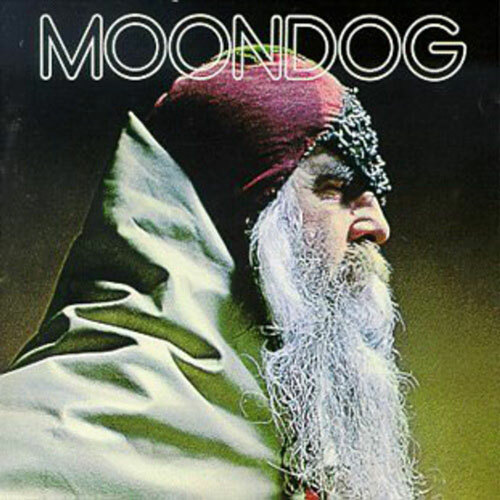
Moondog’s first album for Columbia Records.
Moondog’s legacy: Four of our own influences (musical and otherwise) that were inspired by the music of Louis T. Hardin
It’s probably common knowledge among those familiar with the subject that the music of Louis T. Hardin caught the ears of a great deal of artists, conductors, composers and musicians. Moondog mingled with the likes of Leonard Bernstein, Duke Ellington and Charlie “Bird” Parker, along with many others. But Moondog’s influence extends beyond his contemporaries—into the modern day.
1. R. Stevie Moore. It’s no secret that we’re big fans of R. Stevie Moore. Moore, in turn, is a big Moondog fan. He says he’s a “lifelong admirer” and was influenced by Hardin’s music—something that’s evident in his vast body of work. Not only does he thank Moondog on several albums (Advanst, On Standby, As if Vinyl Didn’t Exist, Greatest Hits, the Verve 2016 CD reissue), he’s also covered a few pieces in his long career. His cover of “Here’s To John Wesley Hardin” is an almost meticulous reconstruction of the original, complete with a fantastic vocal impression that nails the spirit of the original.
Perhaps most interesting is some of the spoken word work he’s been doing. A recent album, The Embodiment of Progressive Ideals (performed with Alan Jenkins), is strongly reminiscent of Moondog’s poetry and prose. It’s uniquely Moore, but the strength of Moondog’s influence continues to extend into his modern work and informs some of his DIY compositional style.
2. Dr. Demento. Moondog’s music makes several appearances on Barret Hansen’s The Dr. Demento Show.
From its days as a nationally syndicated radio show reaching over 400 stations to its current existence as an online subscription show, Hansen made a point to play a wide variety of avant garde, instrumental, experimental, classical, and more alongside the comedy and novelty that made his show famous.
He plays the track “Be a Hobo” more often than any other Moondog piece, but “Tree Frog” and a few others will sometimes be heard in the background as Dr. Demento winds down a set.
Hansen told me he “has no info about Moondog aside from what’s been published,” but says he bought one of Moondog’s records when he was 13 and still enjoys it to this day.
Going all the way back to the second year of the show, he played almost an entire side of that album, Moondog and His Friends, on his April 22, 1971 episode on KPPC_. _In that segment, Hansen describes the record as an “extended play record that cost about $1.50 back in those days [1953].” Fast forward a few years to the four hour show from Jan. 07, 1973, he lines up the set with an anecdote:
Something that I would have played more often, except my copy shows that I bought it when I was 13 years old and didn’t have much of a record player. [Moondog is] One of the American primitives, a word also used to apply to John Fahey, who bought that same record when he was 13 also, as I was delighted to find out.
A listener at the time provided the show with a mint copy of the record from which he played the following “Oasis,” “Tree Frog,” and “Be a Hobo.” Hansen finishes introducing the set by stating: “Though Moondog wouldn’t like the phrase, it certainly was one of the first psychedelic records ever made. Maybe the first.”
Dr. Demento is probably the single biggest influence in my life and career. The Moondog connection inspired me seek his music out for myself. Thanks, Doc!
3. The Residents. Listening to early Residents music, one can hear the influence of Moondog’s compositional style on tracks from the Santadog EP, Meet the Residents and Fingerprince. The rhythms, minimalist composition and almost tribal aspects of those songs run parallel with some of the material from Moondog and Moondog 2.
Per a 2014 interview with KQED, current Cryptic Corporation President Homer Flynn (and let’s be honest, he’s probably the Singing Resident/Randy, too) counted Moondog among many influences on the band—a list that also included the likes of Harry Patch, Sun Ra, the Beatles and Frank Zappa.
The music of The Residents has a timeless quality to it and seems as fresh today as it was in the 1970s. To that point, Flynn remarks:
“Shirley Temple and Moondog still seem fresh to me.”
4. Irwin Chusid. Author/DJ/drummer/journalist Irwin Chusid is an incredible resource of unique music history, dedicating at least five episodes of his radio program on New Jersey’s WMFU to Moondog, most recently in 2018. Chusid also penned the outsider music resource Songs in the Key of Z (a favorite book around here).
Moondog rightly doesn’t have an entry in that book—he was a serious composer whom in no way meets Chusid’s operational definition of outsider musician. However, one of my anecdotes from the book mentions him in its Tiny Tim chapter. In 1962, Tiny Tim regularly played the New York-based Little Theatre, effectively sharing his unique style to the world. The story goes that Moondog would follow Tiny Tim on stage. Though Moondog was mostly a friendly, gracious person, he was clearly not a Tiny Tim fan.
Per Chusid, “When he mounted the stage after Tiny, Moondog reportedly muttered curses about the travesty that preceded him.”
Oh, and Lenny Bruce once joined Tiny Tim and Moondog on that very stage. What a show that must have been! Chusid covers a wide deal of fascinating, compelling music on his WMFU show each week and continues to be a source of inspiration for all of us here at Tedium.
“New York City was my mother and father for 30 years. I worked and slept on her streets and ate through the kind generosity of her people. I would like to go back someday—most of all I would like to have a concert of my music there.”
— Moondog, speaking to The New York Times in 1979, shortly after his relocation to Germany. After moving there because of keyboardist Paul Jordan, there was some uncertainty whether he’d stay. In the end, he spent the rest of his life there, continuing to compose and conduct his works until his passing in 1999.
Though he passed on Sep. 8, 1999, the music of Louis Hardin still lives in the hearts and minds of many. There is a great deal more that can be said about Moondog, but we simply cannot cover it all here. However, reading Robert Scotto’s book Moondog: the Viking of Sixth Avenue will illuminate the life of Louis Hardin in much more detail. Online, Moondog’s Corner is the single best resource for Hardin’s work.
Towards the end of his life, he saw some of his work performed in public and conducted some of it himself by playing the bass drum to lead the other musicians, but Moondog’s music has yet to enter the Classical Canon. One thing is for certain: the name is remembered and perhaps viewers of The Beach Bum will latch onto the name and look for it online, stumbling upon the music. With The Viking of Sixth Avenue about to arrive, the opportunity for the masses to learn more about Moondog is undeniable.
This is only the beginning of the story; Moondog did a number of fascinating things during his life. His disdain for pop music forms, combined with a bit of intellectual property theft on the part of a popular DJ in the 50s led to a lawsuit and a bit of historical significance—but that’s a story for another time.
As for us? We’ll be listening to our favorite Moondog compositions for years to come and telling everyone we can reach about the wonderful world Moondog. The legacy of the Viking lives on his music—and in the performances of those who carry it on into the 21st century and beyond.
--
Find this one a fascinating read? Share it with a pal! (And see you next time!)

